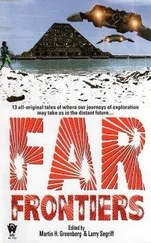The "key" minds on either side, enlightened by "divine messengers," heroically preached peace. And though many of them were hastily martyred, their cause triumphed. The races made terms with each other; all save two formidable and culturally rather backward peoples. These we could not persuade; and as they were by now highly specialized for war, they were a very serious menace. They regarded the new spirit of peace as mere weakness on the part of the enemy, and they were determined to take advantage of it, and to conquer the rest of that world. But now we witnessed a drama which to terrestrial man must surely seem incredible. It was possible in this world only because of the high degree of mental lucidity which had already been attained within the bounds of each race. The pacific races had the courage to disarm. In the most spectacular and unmistakable manner they destroyed their weapons and their munition factories. They took care, too, that these events should be witnessed by enemy-swarms that had been taken prisoner. These captives they then freed, bidding them report their experiences to the enemy. In reply the enemy invaded the nearest of the disarmed countries and set about ruthlessly imposing the military culture upon it, by means of propaganda and persecution. But in spite of mass executions and mass torture, the upshot was not what was expected. For though the tyrant races were not appreciably more developed in sociality than Homo sapiens, the victims were far superior. Repression only strengthened the will for passive resistance. Little by little the tyranny began to waver. Then suddenly it collapsed. The invaders withdrew, taking with them the infection of pacifism. In a surprisingly short time that world became a federation, whose members were distinct species.
With sadness I realized that on the Earth, though all civilized beings belong to one and the same biological species, such a happy issue of strife is impossible, simply because the capacity for community in the individual mind is still too weak. I wondered, too, whether the tyrant races of insectoids would have had greater success in imposing their culture on the invaded country if there had been a distinct generation of juvenile malleable swarms for them to educate.
When this insectoid world had passed through its crisis, it began to advance so rapidly in social structure and in development of the individual mind that we found increasing difficulty in maintaining contact. At last we lost touch. But later, when we ourselves had advanced, we were to come upon this world again.
Of the other insectoid worlds, I shall say nothing, for not one of them was destined to play an important part in the history of the galaxy.
To complete the picture of the races in which the individual mind had not a single, physically continuous, body, I must refer to a very different and even stranger kind. In this the individual body is a cloud of ultramicroscopic sub-vital units, organized in a common radio-system. Of this kind is 'the race which now inhabits our own planet Mars. As I have already in another book described these beings and the tragic relations which they will have with our own descendants in the remote future, I shall say no more of them here; save that we did not make contact with them till a much later stage of our adventure, when we had acquired the skill to reach out to beings alien to ourselves in spiritual condition.
3. PLANT MEN AND OTHERS
Before passing on to tell the story of our galaxy as a whole (so far as I can comprehend it) I must mention another and a very alien kind of world. Of this type we found few examples, and few of these survived into the time when the galactic drama was at its height; but one at least had (or will have) a great influence on the growth of the spirit in that dramatic era.
On certain small planets, drenched with light and heat from a near or a great sun, evolution took a very different course from that with which we are familiar. The vegetable and animal functions were not separated into distinct organic types. Every organism was at once animal and vegetable.
In such worlds the higher organisms were something like gigantic and mobile herbs; but the violent flood of solar radiation rendered the tempo of their life much more rapid than that of our plants. To say that they looked like herbs is perhaps misleading, for they looked equally like animals. They had a definite number of limbs and a definite form of body; but all their skin was green, or streaked with green, and they bore here or there, according to their species, great masses of foliage. Owing to the slight power of gravitation on these small planets, the plant-animals often supported vast super-structures on very slender trunks or limbs. In general those that were mobile were less generously equipped with leaves than those that were more or less sedentary.
In these small hot worlds the turbulent circulation of water and atmosphere caused rapid changes in the condition of the ground from day to day. Storm and flood made it very desirable for the organisms of these worlds to be able to move from place to place. Consequently the early plants, which owing to the wealth of solar radiation could easily store themselves with energy for a life of moderate muscular activity, developed powers of perception and locomotion. Vegetable eyes and ears, vegetable organs of taste, scent and touch, appeared on their stems or foliage. For locomotion, some of them simply withdrew their primitive roots from the ground and crept hither and thither with a kind of caterpillar action. Some spread their foliage and drifted on the wind. From these in the course of ages arose true fliers. Meanwhile the pedestrian species turned some of their roots into muscular legs, four or six, or centipedal. The remaining roots were equipped with boring instruments, which on a new site could rapidly proliferate into the ground. Yet another method of combining locomotion and roots was perhaps more remarkable. The aerial portion of the organism would detach itself from its embedded roots, and wander off by land or air to strike root afresh in virgin soil. When the second site was exhausted the creature would either go off in search of a third, and so on, or return to its original bed, which by now might have recovered fertility. There, it would attach itself once more to its old dormant roots and wake them into new activity.
Many species, of course, developed predatory habits, and special organs of offense, such as muscular boughs as strong as pythons for constriction, or talons, horns, and formidable serrated pincers. In these "carnivorous" creatures the spread of foliage was greatly reduced, and all the leaves could be tucked snugly away along the back. In the most specialized beasts of prey the foliage was atrophied and had only decorative value. It was surprising to see how the environment imposed on these alien creatures forms suggestive of our tigers and wolves. And it was interesting, too, to note bow excessive specialization and excessive adaptation to offense or defense ruined species after species; and how, when at length "human" intelligence appeared, it was achieved by an unimposing and inoffensive creature whose sole gifts were intelligence and sensibility toward the material world and toward its fellows. Before describing the efflorescence of "humanity" in this kind of world I must mention one grave problem which faces the evolving life of all small planets, often at an early stage. This problem we had already come across on the Other Earth. Owing to the weakness of gravitation and the disturbing heat of the sun, the molecules of the atmosphere very easily escape into space. Most small worlds, of course, lose all their air and water long before life can reach the "human" stage, sometimes even before it can establish itself at all. Others, less small, may be thoroughly equipped with atmosphere in their early phases, but at a much later date, owing to the slow but steady contraction of their orbits, they may become so heated that they can no longer hold down the furiously agitated molecules of their atmosphere. On some of these planets a great population of living forms develops in early aeons only to be parched and suffocated out of existence through the long-drawn denudation and desiccation of the planet. But in more favorable cases life is able to adapt itself progressively to the increasingly severe conditions. In some worlds, for instance, a biological mechanism appeared by which the remaining atmosphere was imprisoned within a powerful electromagnetic field generated by the world's living population. In others the need of atmosphere was done away with altogether; photosynthesis and the whole metabolism of life were carried on by means of liquids alone. The last dwindling gases were captured in solution, stored in huge tracts of spongy growths among the crowded roots, and covered with an impervious membrane.
Читать дальше









![Олаф Стэплдон - Создатель звезд [сборник litres]](/books/433148/olaf-stepldon-sozdatel-zvezd-sbornik-litres-thumb.webp)


